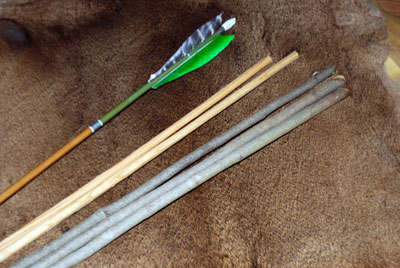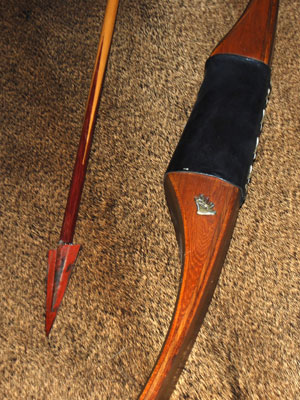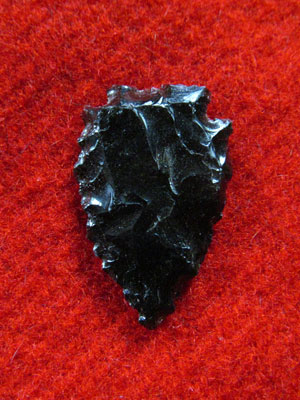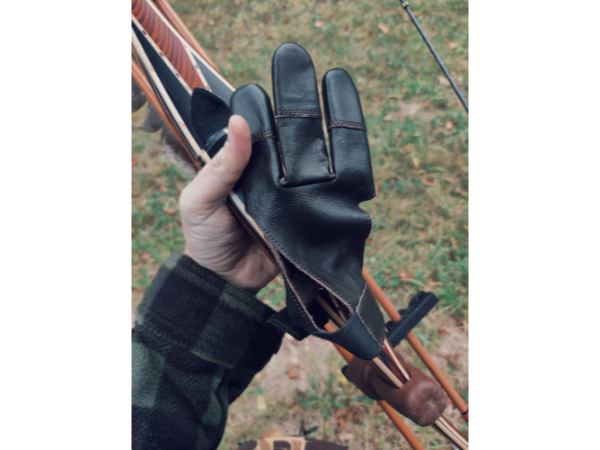I started hunting with traditional gear when I was about 20 years old. My dad and I both made the switch from compounds. He got a Martin Dream Catcher, and I got a Martin Super Diablo. Both were recurves, and both were sweet shooting bows. I spent many hours practicing in the back yard. It was just a pleasure to shoot that bow. I also used to like just looking at the bow. The wood grain was beautiful, and it was a functional work of art.
Part of the reason I made the switch to traditional was, because of a shoulder injury. In high school, I threw out my shoulder pitching in baseball. I subsequently quit baseball, because I could no longer pitch or draw my bow. It was not being able to draw the bow that was the real impetus to quit. Baseball was messing up my hunting, and I did have priorities. The shoulder plagued me for years. I tried chiropractors and physical therapy, but nothing seemed to help. Every time my compound would break over, my shoulder would give and wrack me with pain. When I switched to traditional, I found that the steady, even pull of a recurve didn’t bother my shoulder. In fact, along with some simple exercises it seems to have helped it heal. Traditional archery has proven to be good medicine, and for much more than the shoulder.

Arrow shafting in various stages of completion.
Traditional gear is simple, and consequently there is less to go wrong in the woods. Traditionalists don’t have to worry about snagging their sights or rests in the brush or on a tree step and having to re-tune their bows. I ascribe to the “KISS” method for hunting: Keep It Simple Stupid, and this translates well to living, as well as hunting. Thoreau is famous, in part, for keeping things simple.
Keeping things simple also has another benefit: low-tech methods and tools necessitate that a reliance on personal skill, judgement, and intuition is augmented. There is a sense of woodsmanship and self-reliance inherent in low-tech methods, and woodsmanship and self-reliance are further augmented by making one’s own tools. I’ve always fletched my own arrows, but switching to traditional allowed me to use wooden arrows. I’ve spent many, many hours whittling, straightening, cresting, sealing, and fletching wooden arrows, and I have enjoyed every second of it. In the past few years, I’ve also been trying my hand at bow making, flint knapping, and making cordage. Making and using one’s own hunting gear causes one to rely more on knowledge, personal skill, and the art of hand craftsmanship instead of tool-and-die, CNC machines, computer generated templates, mass production, wheels, pulleys, overdraws, range finders, and lighted sight pins. Many traditionalists are driven to make their own gear, and there is great value in that. Aldo Leopold wrote about this value. On page 181 of A Sand County Almanac he writes: “Homemade aids to sport often enhance, rather than destroy, the man-earth drama; he who kills a trout with his own fly has scored two coups, not one.” The value of which Leopold writes seems to build upon or reinforce the values of woodsmanship and self-reliance, but (for me at least) there is great value in hand fashioning the raw materials God gave us into functional tools. It is a value that does not come from plastic, nickel-cadmium batteries, fossil fuel, or machined parts; not for me anyway. Not that the raw material to make these didn’t come from God (because they did), but the personal involvement is key, as it ignites our creative and artistic faculties. Maybe if I personally mined, smelted, and machined the metal; pumped the oil, refined it, and formed the plastic composite and space-age materials necessary to make a compound bow and arrows I would feel the same connection as I do to a longbow and wood arrows, but I doubt it. I like wood better than metal and plastic: it feels, looks, and performs better for hunting, in my opinion.

Bow and footed arrow.
In addition to the value found from making my own equipment, I just enjoy shooting with traditional equipment. It seems much more personal and visceral than some of the high tech arrow slingers. The personal investment has been increased with traditional gear, and I’ve found that you get out what you put in. That is to say, every second I’ve spent on traditional archery has benefitted me in some way–whether it be contentment in the craft of making equipment, or the concentration and satisfaction of target practice.
Perhaps because of the increased personal investment, traditional bowhunting has an up-close, visceral, intentional, and deliberate quality that other hunting lacks. It is up-close and personal, because the effective range of traditional gear is far less than that of modern gear. Thus, an increase in personal contact. It is visceral, because the bow and arrow is a muscle-powered tool; and instinctive shooting is not mediated by peep sights and pins. It is pure hand-eye coordination. Traditional bowhunting is intentional and deliberate, because it takes a tremendous amount of focus, concentration, mindfulness, and will power to send an arrow exactly where it is instinctively intended. We do this only with every fiber of our being focused on a single spot, and there is value in exercising intentionality and living deliberately. Again, Thoreau is famous, in large part, because he “…went to the woods to live deliberately.”
There is, perhaps, an even more beneficial implication of adopting certain forms of technology over others. In In Defense of the Land Ethic J. Baird Callicott writes that to adopt a culture’s technology is to adopt their worldview. He writes: “…to adopt a technology is…to adopt the world view in which the technology is embedded.” (Callicott, 205) The bow and arrow has a long history, and this quote leads me to wonder what sort of values we may be adopting by using the bow; and the low-tech varieties, in particular.
For one thing, the visceral and personal aspect of bowhunting could cause us to rethink some of the metaphysical and moral assumptions that frame our culture. The visceral aspect of hunting: the focus and use of every fiber of one’s being to make a killing shot requires the use of mind and body in a fundamental unity. This undercuts the prevailing mind/body dualism inherent in Western philosophy.

Home made hunting point.
Also, hunters meld the use/respect dichotomy inherent in much of animal welfare ethics and other “inclusive” moral theories. For the hunter, there has never been a contradiction in holding high regard for his/her prey and killing and utilizing them for food, clothing, or tools. This is in contrast to many theories that stop moral consideration for those beings who are utilized or have a “hands off” approach to those beings they do consider morally significant. Neither of these has ever been the case for the hunter.
Furthermore, if our personal experience with living beings and landscapes teaches us that these beings are imbued with purpose, self-direction, and wills of their own, this may cause us to re-examine the mechanistic, atomistic, and deterministic explanations of matter and the natural world. When the motivating force of action comes from within the object (or subject) itself, this definitely undercuts mechanistic metaphysics and the usual subject/object categories we are taught in grammar lessons. Native Americans believed that all components of the natural world were enspirited–this belief is called “Animism.” They were also bowhunters.
With the acknowledgement of the animals’ self-direction and animistic qualities comes the moral idea that other organisms are ends in themselves and not merely a means to an end. A priori designations such as money, trophy, resource, or cohort thus seem inappropriate. We do not in good faith use such designations for others we view as ends. Why do it for members of the biotic community? When treated as ends in themselves, it means members of the biotic community have interests and value regardless of, or primarily and in addition to, our use for them. That is to say, they are not valued solely in instrumental terms, and may be seen as members of a community. This also undercuts dominant Western moral theories whereby nature is valued only for what it can do for people. Again, the belief that members of the natural world are also members of a community is a belief shared by Native Americans. Aldo Leopold is known for considering members of the natural world as members of a moral community. This is a cornerstone of his Land Ethic. Leopold was also a bowhunter, and a traditionalist who made his own gear to boot. I don’t believe this is a coincidence.
Lastly, when we participate existentially with the biotic community (that is, by hunting for our nourishment) we undermine the human/nature dichotomy that also prevails in Western thought. Nature is not something foreign, morally “Other,” or of lesser value to the bowhunter. Hunting for one’s sustenance deals with life on a level that few things can.
I believe all of these values are latent in traditional bowhunting, and they are beneficial to us, the places, and the beings we hunt. Pragmatically, it doesn’t seem to matter whether the technology leads us to these values, or if we seek the technology, because we already hold the values. They are consistent with, deducible from, and augmented by traditional bowhunting. Traditional bowhunting has opened the door to a world of meaning, value, and philosophy. Hunting is very personal and meaningful by nature. Consequently, the more one invests into this process, the more one gets in return. At least that’s what I’ve found to be true, and I have never thought any of the time spent on traditional archery was wasted time. I get contentment, value, and meaning from every step of the process. This is as it should be.







Leave A Comment